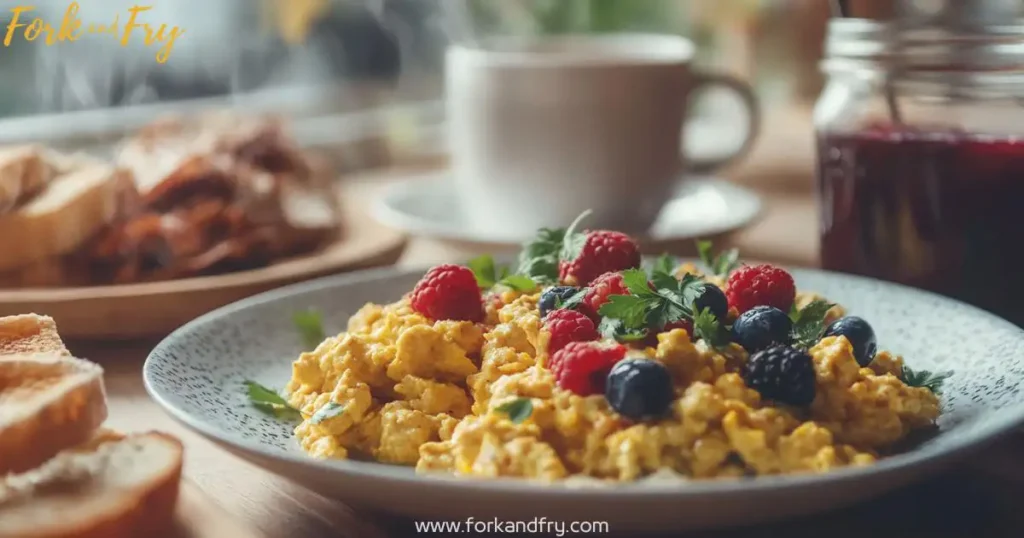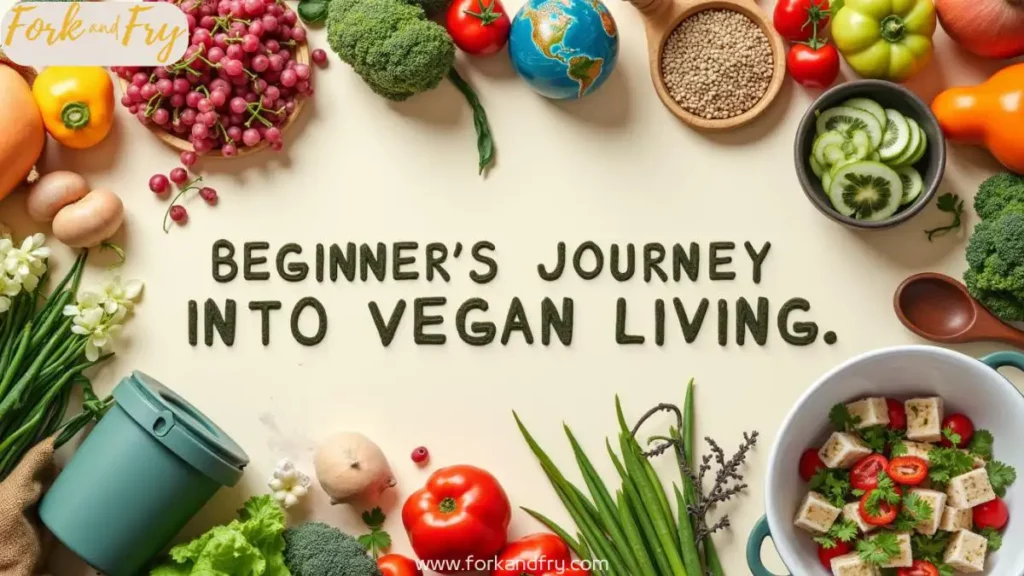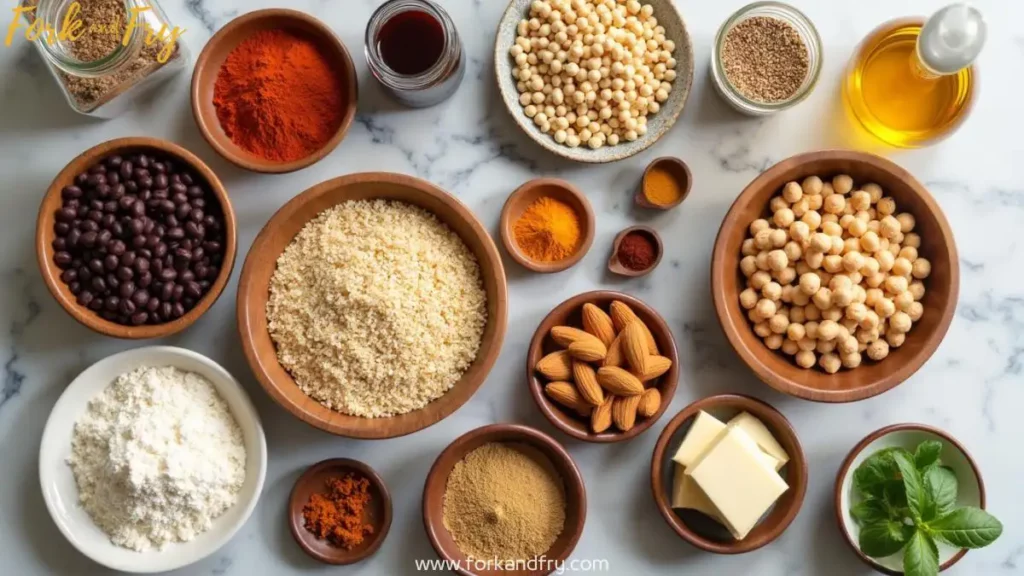Last updated on March 28th, 2025 at 02:51 pm
Table of Contents
Imagine waking up at 6 AM and rushing to get breakfast before the kids leave for school. What if you could make a tofu scramble in just 7 minutes? It’s made with veggies, turmeric, and a bit of nutritional yeast.
Or think about a dinner where everyone wants seconds of vegan steak strips in under 20 minutes. These meals are not just dreams—they’re real and available here.

High protein plant based meals don’t have to be hard to make or taste bad. The protein veggie smoothie is a quick 3-minute blend of spinach, silken tofu, and frozen mango.
The chickpea sweet potato bowl cooks veggies while you shower. Then, it mixes quinoa and avocado for a filling lunch. The vegan taco salad is ready in 15 minutes with tortilla chips and black beans.
Key Takeaways
- 15+ plant-based protein recipes under 80 minutes, from 3-minute smoothies to hearty dinners.
- Recipes tested to work for busy schedules, using pantry staples like chickpeas and quinoa.
- Perfect for vegans and omnivores—try the vegan charcuterie lunchbox or protein pancakes for family-friendly options.
- No special skills needed—step-by-step guides simplify tofu scrambles, protein oats, and more.
- Save time with meal prep: the vegan salad meal prep and high protein veggie ground beef make weeknight dinners effortless.
Why Plant-Based Proteins Are Perfect for Busy Lifestyles

Plant-based proteins are a game-changer for quick, healthy meals. Imagine making our easy cabbage soup without lifting a finger. These ingredients do all the work, saving you time. Here’s why plant-based proteins are a game-changer for busy weeks:
Health Benefits of Plant-Based Proteins
Lentils and chickpeas are protein powerhouses, packed with fiber and nutrients. They’re a healthier choice than meat, with less saturated fat. Try quinoa salads or chia pudding for meals that keep you full and focused.
Research shows these options can lower heart disease risk. They also curb cravings better than processed snacks.
Environmental Impact of Plant-Based Eating
Eating less meat can greatly reduce your carbon footprint. Beans and legumes need much less water than beef. Choosing vegan protein recipes like our quick ginger beef & broccoli bowls benefits both you and the planet.
Cost-Effectiveness of Plant Proteins vs. Animal Proteins
Beans are a fraction of the cost of steak. A can of black beans (15g protein) is just $1.50, while chicken breast costs $5/lb. Freeze leftovers to make meals last longer. Canned beans and frozen veggies also save time and reduce waste.
With easy plant based protein recipes, busy kitchens thrive. Try swapping ground beef for lentils in tacos or making overnight oats with hemp seeds. Every change saves time, money, and energy, making your meals healthier.
Plant Based Protein Recipes That Save Time Without Sacrificing Flavor
Imagine meals that fuel your body and your busy schedule. These protein-rich vegan recipes show that tasty plant protein meals don’t need hours to make. Whether you’re planning meals for the week or cooking on the fly, each dish here is quick and satisfying.
“The right ingredients and prep turn 30 minutes into a masterpiece.” — Kitchen Hack Insider
- Avocado Toast with Chickpeas & Tahini: 15g protein in 10 minutes—toast, mash, layer.
- Classic Red Beans & Rice: A 38g protein powerhouse. Simmer beans, mix with spices, serve over rice. Freezes perfectly for quick reheats.
- Spicy Tofu Tacos: Crispy tofu, zesty slaw, and warm tortillas ready in 20 minutes. Swap tortillas for lettuce wraps for low-carb twists.

These recipes use common items like canned beans, pre-soaked grains, and frozen veggies. Cook quinoa or lentils on Sunday for weekday lunches. Use tempeh in salads to save time. Even the delicious plant protein meals like lentil bowls or edamame salads use everyday grocery store items. No need for special aisles.
Think of your oven as a timesaver: roast a tray of veggies and chickpeas while simmering a curry base. Small steps add up—like pre-chopping herbs or marinating tofu overnight. Every recipe here is designed to fit your schedule without sacrificing taste. Next up: breakfasts, lunches, and dinners that show busy nights and bold flavors can go hand in hand.
Quick and Protein-Packed Breakfast Options

Mornings don’t have to mean cereal or toast. These high protein plant based meals fuel your day with minimal effort. Each recipe takes 20 minutes or less, and most can be prepped the night before. Perfect for busy schedules, these protein-packed plant based dishes keep you energized until lunch.
Tofu Scramble Breakfast Burrito
Crispy tofu cubes mimic scrambled eggs with 15–20g protein per serving. Season with turmeric for a sunny hue and nutritional yeast for cheesy depth. Wrap in a tortilla with avocado and salsa for a vegan protein recipe that’s freezer-friendly. Prep veggies ahead of time for even faster mornings.
Overnight Protein Oats Three Ways
Batch prep these easy plant based protein recipes in jars overnight. Mix rolled oats, plant milk, protein powder, and your choice of toppings. Try chocolate-peanut butter, berry-almond, or apple-cinnamon varieties. Each jar delivers 21.9g protein and costs under $4 per serving. Top with pumpkin seeds ($3.69/bag) for crunch and extra protein.
Chickpea Flour Pancakes with Berry Compote
Whisk chickpea flour with baking powder and water for fluffy plant based protein recipes in 5 minutes. Cook in batches, freeze extras, and toast them later. Serve with fresh or frozen berries for a delicious plant protein meal. Each pancake has 12–15g protein—perfect for weekend brunches or quick weekday mornings.
5-Minute Peanut Butter and Hemp Seed Toast
Spread whole-grain bread with creamy peanut butter and sprinkle hemp seeds for 12g protein in minutes. Add cinnamon, banana slices, or a drizzle of maple syrup for sweetness. This healthy plant based protein recipe uses pantry staples and adapts to dietary needs—swap almond butter for peanuts if needed.
These vegetarian protein recipes prove breakfast doesn’t require extra time or effort. Mix, prep, or freeze ahead to make mornings smoother. Your first bite of these high protein plant based meals will kickstart your day with flavor and focus.
Lunch Recipes Ready in Under 20 Minutes
Midday hunger doesn’t mean you have to grab takeout or a boring sandwich. These easy plant based protein recipes show you can have tasty meals even on busy days. Whether you’re packing lunch for work or eating at home, these options are packed with protein. Ready to skip the lunch rush? Let’s dive in.

Lentil and Quinoa Power Bowl
Start with pre-cooked lentils and quick-cook quinoa. Add roasted veggies and a zesty tahini drizzle. This high protein plant based meal has 20g protein per serving. Prep veggies ahead and store them in airtight containers. Assemble in 5 minutes on hectic days.
Swap veggies based on what you have in your fridge. Try roasted Brussels sprouts or spinach.
Smoky Tempeh Wrap with Avocado Spread
Sliced tempeh marinated in smoky paprika and lime simmers for 15 minutes, then pan-seared. Pair it with creamy avocado-mayo spread and your choice of lettuce, tomato, or jalapeo. This vegan protein recipe has 18g protein and is great for on-the-go days. Double the tempeh batch for leftovers!
Edamame and White Bean Salad
This no-cook protein-rich vegan recipe mixes edamame, cannellini beans, and cucumber in a lemon-dill dressing. Add cherry tomatoes and parsley for a crisp, refreshing bowl. Store in a mason jar for 3 days—ideal for meal prep. Each serving has 31g protein, making it a standout high protein plant based meal.
Microrowave Bean and Rice Burrito
Combine canned beans with rice, salsa, and nutritional yeast in a tortilla, wrap, and microrowave for 1-2 minutes. These easy plant based protein recipes offer 15g protein and freeze well. Add jalapeo, corn, or hot sauce for extra kick. Perfect for when you need lunch in 5 minutes!
Quick Lunch Breakdown
| Recipe | Prep Time | Protein (g) | Highlights |
|---|---|---|---|
| Lentil & Quinoa Bowl | 20 mins | 20g | Meal-prep friendly, customizable veggies |
| Smoky Tempeh Wrap | 15 mins | 18g | Wraps stay fresh for 3 days |
| Edamame Salad | 10 mins | 31g | No-cook, fridge-ready |
| Microrowave Burrito | 5 mins | 15g | Freezable, 2-ingredient base |
Pair these delicious plant protein meals with a side of fruit or whole-grain chips. Adjust spice levels to match your taste—cumin, chili powder, or fresh herbs take flavors to the next level. Your lunch break just got a whole lot tastier—and easier.
Hearty Dinner Recipes That Impress Without the Stress
Evening meals don’t have to be stressful. These vegetarian and vegan recipes are easy to make and delicious. Imagine a creamy adzuki bean noodle bowl or a Creole jackfruit jambalaya. Both are packed with plant-based protein and taste amazing.
These dishes are perfect for any meal, whether you’re cooking for a crowd or just one. They offer bold flavors and textures that everyone will love.
- Asian-style Noodle Bowl: Adzuki beans, tofu, and veggies in a zesty sauce—ready in 25 minutes.
- Creole Jackfruit Jambalaya: A hearty dish with smoky jackfruit, beans, and veggies, perfect for a weeknight.
- Moroccan Chickpea Stew: Warm spices and tender chickpeas create comfort in a bowl—no meat needed.
- One-Pot Vegan Chili: Kidney beans and jackfruit simmered into a rich, protein-packed chili with a 30-minute prep time.
- Cauliflower Shepherd’s Pie: Mashed cauliflower tops a savory lentil and veggie filling—cleanup is a breeze!

These recipes are all about flavor and ease. Our Easy Vegan Veggie Wrap is a quick option with roasted veggies and hummus. The Baked Tofu is a great protein source for many dishes. Even the Crispy Vegan Air Fryer Onion Rings are perfect with soups or stews.
Most meals offer 15-30g protein per serving. This keeps you full without the need for complicated recipes.
From a comforting lentil bolognese to a vibrant rainbow veggie roll, these dinners are both nourishing and simple. You don’t have to choose between taste and convenience. These recipes offer both!
Meal Prep Strategies for Weekly Plant Protein Success
Imagine enjoying protein-packed plant based dishes without daily kitchen chaos. Meal prep makes busy weeks stress-free. Start by prepping versatile proteins like tempeh, lentils, or chickpeas in bulk. These high protein plant based meals are the base for lunches and dinners, ready to be quickly reheated or tossed into salads.
Begin with batch cooking—a 2-hour weekend session can last the week. Roast a sheet pan of veggies while simmering lentil bolognese. Cook grains like farro or brown rice in big batches. Pair with marinated tofu or soy curls for delicious plant protein meals. Our favorite? Slow cooker tomato-braised lentils—simmer overnight for a flavor-packed base to use in bowls, wraps, or salads.
- Freezer-Friendly Options: Freeze pre-cooked tempeh strips or bean burgers for last-minute dinners. Try our Sloppy Vegan Joes recipe—portions freeze perfectly for 3 months. Label bags with dates and ingredients to avoid “freezer amnesia!”
- Mix-and-Match Magic: Divide prepped ingredients into containers. Combine black beans + quinoa + avocado salsa one day, then the same beans in a spinach wrap the next. This keeps meals fresh without extra cooking.
- Storage Secrets: Store proteins in airtight containers. Marinatee cooked grains with olive oil to prevent drying. Keep sauces like tahini dressing separate for longer freshness.
Even beginners can start small—prep just 2 proteins and 1 grain weekly. Swap ingredients like edamame for tofu if you’re short on time. With these strategies, your weeknight dinners become a rotation of easy plant based protein recipes instead of a scramble.
Essential Kitchen Tools for Plant-Based Protein Preparation
“I’ve been making this easy dinner recipe for my family on repeat—it’s always such a win!”
A sharp chef’s knife and sturdy cutting board are key for prepping beans, veggies, and tofu. A high-powered blender makes creamy sauces from nuts. These are the must-haves:
- Chef’s knife + cutting board: Chopping tempeh or slicing roasted chickpeas.
- Pressure cooker: Cuts bean cooking time by 75%—perfect for chili or lentil soups.
- Food processor: Grinds falafel mix or purees hummus in seconds.
- Silicone baking mats: Oil-free roasting for tofu or veggies—no stick, no mess.
| Essential Tools | Nice-to-Have |
|---|---|
| Measuring cups (for portioning grains) | Tofu press (for firm tofu) |
| Mason jars (meal prep storage) | Immersion blender (on-the-go blending) |
| Crockpot (slow-cooked chili) | Mandoline (thin-sliced veggies) |
Begin with the basics: knife, cutting board, and a 6-quart pot. Choose tools that do more than one thing. A $15 colander makes rinsing quinoa or lentils easy. Each tool helps you cook protein-rich vegan recipes faster and smarter.
Pantry Staples and Smart Substitutions
Your pantry is key to quick, easy plant based protein recipes. Here’s how to stock up for high protein plant based meals easily.
Must-Have Protein-Rich Ingredients
Start with these core items for vegan protein recipes that work overtime:
- Legumes: Canned black beans, chickpeas, or lentils add 15g protein/cup. Swap dry beans for quick-cooking lentils in protein-packed plant based dishes.
- Grains: Quinoa (complete protein!) and farro boost bowls, while oats make 5-minute breakfasts.
- Nuts/seeds: Keep almond butter, chia seeds, and pepitas on hand for crunch and protein.
Easy Swaps When You’re Missing Ingredients
| Missing? | Swap With |
|---|---|
| Tempeh | Firm tofu or textured Veg Protein |
| White beans | Chickpeas or cannellini beans |
| Nutritional yeast | Sun-dried tomatoes + lemon zest (for umami) |
Always choose swaps that keep protein high—like edamame instead of snap peas.
Flavor Boosters for Plant Proteins
“A dash of miso turns plain tofu into a party.”
Amplify taste with these long-lasting essentials:
- Umami: miso paste, sun-dried tomato paste, or mushroom powder
- Acids: fresh lime juice, apple cider vinegar
- Herbs: Fresh cilantro or dried oregano for instant depth
Pair bold flavors with basics like healthy plant based protein recipes. Try sesame-ginger tofu with spinach for under 15 minutes.
Conclusion: Embracing Plant-Based Protein for Easier, Healthier Meals
Plant-based protein recipes are easy to start with. They show that meals like chickpea pancakes or edamame stir-fries can be part of your daily life. As a busy parent, I’ve made these dishes a staple because they’re quick and nutritious.
Starting small is key. Try replacing one meat-based meal with a quinoa salad or tempeh wrap each week. These recipes use common ingredients like chia seeds and canned beans. This way, you can make healthier choices without spending more time or money.
Plant-based eating is about finding joy in simple meals. The recipes here are quick and easy to clean up. Every choice you make, like choosing black bean tacos, adds up to better health and a greener planet. Let these dishes be your starting point, and let curiosity guide you from there.
FAQ
What are some easy plant-based protein recipes for busy people?
Try quick recipes like Tofu Scramble Breakfast Burritos or Microwave Bean and Rice Burritos. They are tasty and fast to make, ideal for a busy schedule.
How can plant-based proteins benefit my health?
Plant-based proteins are good for your heart and digestion. They offer essential nutrients and help lower disease risks.
Are plant-based meals expensive compared to meat-based ones?
Many plant proteins, like lentils and beans, are cheaper than meat. Buying dried beans in bulk saves money and keeps you healthy.
What types of plant-based ingredients are essential for a well-stocked pantry?
Must-haves include dried beans, lentils, nutritional yeast, canned beans, and textured vegetable protein. These help you make quick, protein-rich meals.
How can I freeze plant proteins effectively?
Freeze cooked beans, tempeh, and lentil dishes in portions. This makes it easy to thaw just what you need for meals.
What are some quick plant-based breakfast options I can make?
Try Overnight Protein Oats or Chickpea Flour Pancakes. Both can be made ahead or quickly in the morning to start your day right.
How do plant-based proteins help the environment?
Plant protein needs less land, water, and energy than animal protein. Choosing plant-based options helps the planet.
Can I meal prep with plant-based proteins?
Yes! Spend a few hours on the weekend cooking plant proteins like lentils and quinoa. This makes healthy meals easy to prepare all week.
Enjoyed this recipe? Leave a review!
There are no reviews yet. Be the first one to write one.






